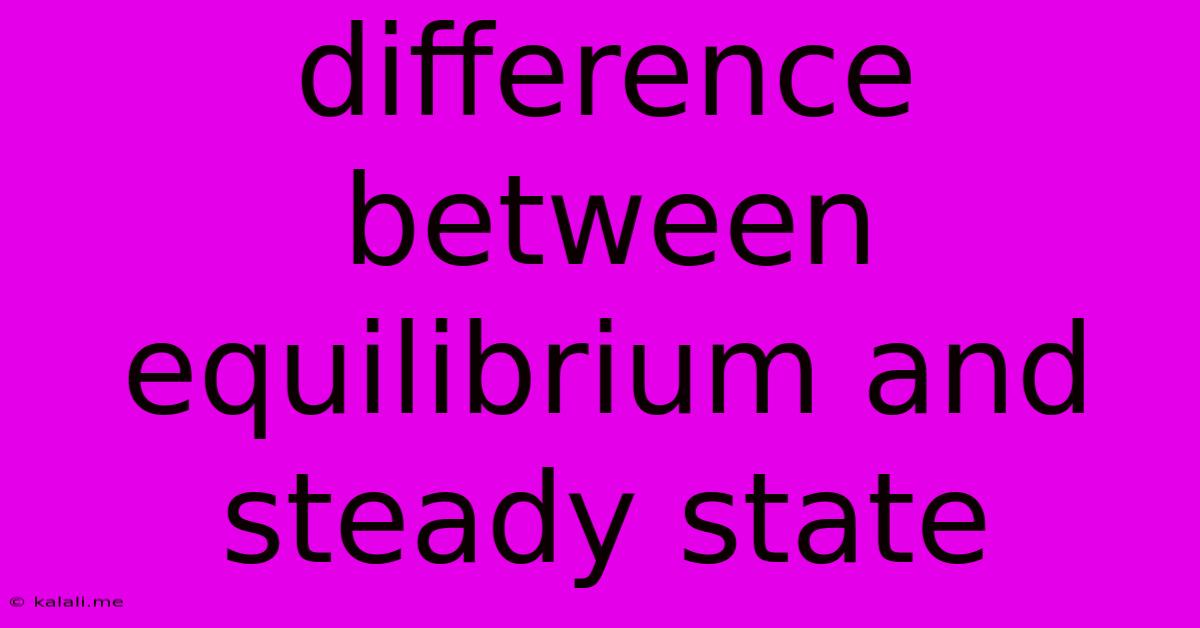Difference Between Equilibrium And Steady State
Kalali
May 31, 2025 · 3 min read

Table of Contents
Equilibrium vs. Steady State: Understanding the Key Differences
Understanding the difference between equilibrium and steady state is crucial in various scientific disciplines, from physics and chemistry to economics and ecology. While both terms describe a system that isn't changing over time, they differ significantly in the underlying processes and conditions. This article will delve into the core distinctions, clarifying the nuances of each concept. This will help you understand complex systems and their behavior, whether you're a student, researcher, or simply curious about the natural world.
What is Equilibrium?
Equilibrium refers to a state where there is no net change in a system's properties. This means that opposing forces or processes are perfectly balanced. Crucially, at equilibrium, there is no driving force for the system to change. The system is at a stable point. Consider a chemical reaction: at equilibrium, the rate of the forward reaction equals the rate of the reverse reaction, resulting in no net change in the concentrations of reactants and products. This is a dynamic equilibrium – even though there's no overall change, individual molecules are still reacting.
Key characteristics of equilibrium:
- No net change: All processes are balanced, leading to a static overall state.
- Reversibility: Small disturbances will be counteracted, returning the system to equilibrium.
- Minimum potential energy: For many systems, equilibrium represents a state of minimum potential energy.
- Absence of driving forces: No external forces are pushing the system to change.
What is a Steady State?
A steady state, on the other hand, describes a system where certain properties remain constant over time, but only because of continuous inputs and outputs. This means there's a constant flow of energy or matter into and out of the system, maintaining a stable state despite the ongoing processes. Think of a river – the water level might remain constant, representing a steady state, even though water is continuously flowing in from upstream and out downstream. The overall state is constant despite the dynamic flow.
Key characteristics of a steady state:
- Constant properties: Certain properties remain unchanged over time, despite continuous fluxes.
- Irreversibility: Small disturbances may take the system away from the current steady state.
- Requires continuous energy input/output: Unlike equilibrium, a steady state depends on continuous flows.
- Open system: A steady state is always associated with an open system exchanging materials and/or energy with its surroundings.
The Crucial Difference:
The fundamental difference lies in the presence or absence of fluxes. Equilibrium implies the absence of any net change, while a steady state requires continuous flows to maintain a constant overall state. Equilibrium is often a static state, while a steady state is dynamic and requires energy to be maintained.
Examples illustrating the difference:
- Equilibrium: A saturated solution of salt in water. The rate of salt dissolving equals the rate of salt precipitating, leading to a constant concentration.
- Steady State: A living organism. Continuous intake of nutrients and expulsion of waste are necessary to maintain its internal conditions. The organism's overall structure and function remain relatively constant despite the constant exchange of matter and energy. This internal homeostasis relies on a steady state.
In Summary:
While both equilibrium and steady state describe systems that appear unchanging over time, the underlying mechanisms differ substantially. Equilibrium represents a balance of opposing forces without any net flow, while a steady state requires continuous inputs and outputs to maintain its constant properties. Understanding this distinction is crucial for comprehending the behavior of diverse systems across various scientific fields.
Latest Posts
Latest Posts
-
How To Change Print Speed On Ender 3v3 V2
Jun 01, 2025
-
How To Remove Company Monitoring From My Personal Phone
Jun 01, 2025
-
2 3 Way Switches 2 Lights
Jun 01, 2025
-
Can You Frequent Trade On Cfd Account
Jun 01, 2025
-
How To Spell The Sound Of Crying
Jun 01, 2025
Related Post
Thank you for visiting our website which covers about Difference Between Equilibrium And Steady State . We hope the information provided has been useful to you. Feel free to contact us if you have any questions or need further assistance. See you next time and don't miss to bookmark.